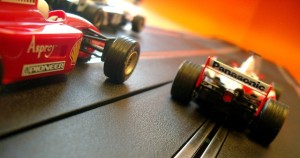Quitting is Hard: Envisioning the Future
This is the first post in a series on how Quitting is Hard (QiH). Each post will explore why quitting is good, one potential barrier to quitting, and a way to overcome it.
Why is quitting important?
Among other benefits, quitting offers you a fresh start. It's a way of picking up a new role with new responsibilities, new colleagues, and new opportunities for growth. You do want to make the kind of bold career change needed for a Ganesh-able Moment, don't you?
[caption id="attachment_40" align="alignright" width="300"] vroom vroom…[/caption]
vroom vroom…[/caption]
Why is quitting hard? Visualization.
You've been in your current job on a certain career path for a while. You're probably pretty good at it. You have the resumé, experience, and network to keep doing what you're doing. You are like a Formula One racecar: finely tuned for optimal performance, on a track, and racing towards a finish line in the distance. Can you imagine racing down a different track, instead?
You might plan to eventually make a change in your career. But visualizing a different future and a different opportunity is a stumbling block for a number of pe0ple I've advised. You have to break free, even just for a moment, to become receptive to everything out there.
How do we overcome this obstacle? Visualization!
You've heard that visualization is a powerful tool, but it also falls in the realm of "self-help" gurus, motivational speakers, and others who want to "Maximize Your True Potential." But behind all the marketing, there are useful, solid scientific foundations - that also carry some risk.
Jo Tango (@jtangoVC) is a venture capitalist who recently wrote a great post about how he decided to start his own investment firm and later applied the technique to an entrepreneur friend of his, called "How a Blank Sheet of Paper Changed My Life."
With credit to Jo, I want to remix this idea a bit.
- Grab a blank piece of paper and a pen. The right tools for an important job.
- Get a little quiet time. Even just 15 minutes. Ideally not on a work day - you want a fresh mind, free of mental baggage from work.
- Ask yourself a few questions: In an ideal future, where am I? What am I doing? What kind of people (if any) am I interacting with?
- Let your mind wander. Go where it takes you. Resist the urge to think about your current position.
- Write or draw. Putting your thoughts down on paper makes a big difference; it gives you something tangible to look at. You can either build upon it or take a different direction, but in either case you are making progress.
Our goal here isn't to build a life plan, or even a career plan; it's to jump-start your career visualization skills. This way when an opportunity comes along, it's easier to imagine yourself in that role and making that leap.
My personal experience
I went through a similar exercise at the start of my MBA program, and found the experience both cryptic and enlightening. To paraphrase my experience: I saw myself in open spaces, interacting with many people, learning about their passions, and really helping them. But what did it all mean? Coming from a purely technical background this felt strange at first. But then I started to look into opportunities in HR and VC, areas I'd never considered before. It began a period of exploration which has been an incredible journey. Now I'm working on Disqovery; I was guided by this exercise and the experiences that followed.
I'm racing on a different track now.
If you have a visualization write-up or doodle you want to share (even anonymously), share it with us and we'll collect and post them on our blog. We here at Disqovery are working on incorporating activities very similar to this one into our app. If you're interested in this space, drop us a line. You can sign up for our closed beta on this page or check us out at disqovery.com.